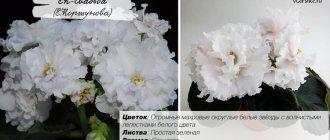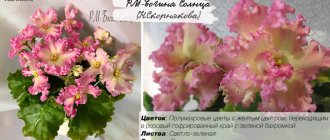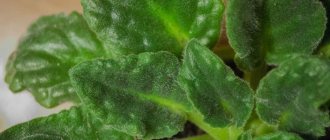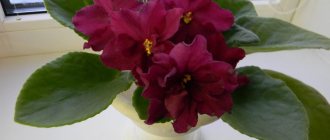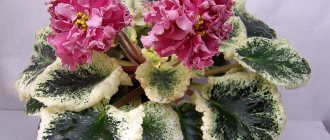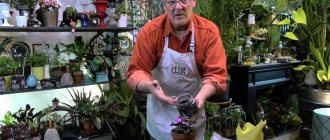General description of the plant
Violet "Optimara" is not a specific variety of plant, but the name of a company that grows Saintpaulia (the second name for violets). The varieties developed by the company usually have the prefix Optimara in their name. Optimara violets are prominent representatives of tropical plants.
The slightest cold can harm them and stop flowering. The roots need warmth; only under this condition will the plant bloom.
These varieties of violets are not viable, which affects their distribution. African violets are not suitable for propagation or distribution . But depending on care, they can produce excellent cuttings, thereby extending their life. Optimara violets are sold in small pots and used as a one-time bouquet, since the buds appear only once.
After the plant fades, it is disposed of. Among the huge variety of types of Optimara violets, one can find similarities in appearance.
All Saintpaulias have rapid growth from cuttings to the appearance of a flowering rosette . Flowers bloom at the same time. The number of flowers during the flowering period is very large. The sockets themselves are small.
Violets are intended for industrial cultivation and are therefore very transportable and unpretentious. The flowers of the plant can have different shades, but they all have a rich color. The flowers of Optimara violets are symmetrical.
Saintpaulias have an underdeveloped fibrous root system . The stems of this violet are fleshy with basal leaves. The leaf has different shapes, depending on the variety it can be round, ovoid, oblong and with a heart-shaped or simple base.
The end of the leaf may have a sharp or rounded tip. There may be small or large teeth along the edges; there are also edges with no relief, slightly rounded.
The leaf of the Optimara violet can be flat, slightly wavy, strongly corrugated, or resemble the shape of a spoon, or a back-curved spoon. Almost always, Saintpaulia leaves are colored in various tones of green, but there is an exception; in some types of violets, the leaf may have areas colored cream, olive, light green, yellow or pink.
Multi-colored areas can be located at the base, along the edges of the leaf blade, or form various mosaic patterns on its surface. The underside of a violet leaf is usually silvery-green , although some varieties or species of violets often have various shades of red in its color.
The surface of the leaves can be glossy or matte, which is covered to varying degrees with hair. The sheet may have a blistered or "quilted" texture.
Description
Very often in everyday life there are plants whose names do not quite correspond to their original name. So, the violet that can be seen on most windows is actually called Saintpaulia. These are plants that have a beautiful shade and belong to the Gesneriev family. The most common version of this flower is the Uzambara violet, which can be easily purchased and grown at home.
Saintpaulia comes from East Africa and can often be found near rivers and ponds, in places where the soil is well moistened. The flower was found in 1892 by Baron Walter von Saint-Paul, who collected the seeds of the plant and brought it with him to his homeland in Germany. It was in his honor that the culture began to be called Saintpaulia. Since 1893, this plant has been actively exhibited at exhibitions in Germany, from where it has spread throughout the world.
Due to the great interest in this plant, today we can count more than 32 thousand varieties, two of which are products of domestic floriculture. Saintpaulia is a short-stemmed evergreen perennial flower whose leaves grow from the root. The foliage may be plain or have spots. A distinctive feature is the presence of villi and the round shape of the sheets, reminiscent of a heart. As for the flowers, they consist of 5 petals, which are collected in a brush. Inside there are 2 stamens and 1 pistil with a superior ovary, and there are also 2 carpels.
Saintpaulia seeds are in a capsule and are small round grains with a straight embryo. There is an option for planting violets using leaves, which are cut off from the main bush and placed in water until roots appear, after which they can be planted in the ground. The soil should be purchased for Saintpaulia or mixed with leaf, turf, coniferous and peat soil in a ratio of 3: 2: 1: 1
In order for violets to grow well, it is important to make the soil loose, for which you cannot do without raising agents: perlite, vermiculite, river sand and sphagnum. For good growth and flowering, it is necessary to water the flowers, not allowing the soil to dry out too much and not flooding the pot, in order to prevent rotting of the roots or the appearance of diseases
When and how did the flower appear?
In 1930, the first violets were grown in the company's greenhouses.
In addition to Saintpaulias, the company was engaged in breeding other plants. Each species took its place in the greenhouses; the African violet, for example, was allocated only 1 square meter. But one day the owner of the company, Herman Holtkamp, decided to change the company’s model and deal only with Saintpaulia. Then active work began on creating new varieties, and already in the mid-twentieth century the company achieved great success. The first commercial variety from Holtkamp's selection (1952) was Sankt Martin . Thus began a large-scale breeding of violets, the company began to develop more and more new varieties of Saintpaulia, and little by little they forced almost all existing plants out of the greenhouses.
In 1961 the company changed its name from Dorrenbach-Holtkamp to Hermann Holtkamp Greenhouses. In 1977, greenhouses for growing Saintpaulia were opened in Nashville, Tennessee, and the Optimara trademark was patented.
History of appearance and distribution
They fascinated him so much that he collected their seeds and sent them to his father, who headed the dendrological society.
He sent the find to his friend Wendland, a biologist. Wendland, in turn, set to work on selection. He developed a number of varieties based on the obtained seed material. Having described the type of plant, giving it scientific characteristics, the biologist named them in honor of the discoverer Saint-Paul. This is how Saintpaulia Uzambara or the familiar violets appeared.
The Optimara trademark has existed for about half a century, but the day of creation of the progenitor company lies behind a century-long statute of limitations. In 1904, M. Dorrenbach in the German city of Isselburg organized a small family business for the selection and cultivation of grain crops, and only in the thirtieth year his son-in-law Holtkamp, a professional gardener, got the idea of \u200b\u200bgrowing Saintpaulia.
It was then that Hermann Holtkamp set and predetermined the fate of the Optimara violets. As a co-owner of the company, Holtkamp had the foresight to believe that global prospects were hidden in this cute African flower. That’s what he called Saintpaulia – plants of the future.
Read also: Do-it-yourself dehydrator for vegetables and fruits
Holtkamp enthusiastically began to implement his intention, but during the war he had to pause and when the work was later resumed, the first successes appeared. By the way, later his grown-up son, Reinhold, entered the family business with no less zeal and made a huge contribution to its development.
The beginning of such a large and long journey of Saintpaulia-Optimara was laid on one square of the square. The first batch of these plants, among other seedlings grown in the greenhouse, occupied just one meter by one meter.
Every year the number of violets in the greenhouses of Optimara increased and gradually these travelers from the Uzambara islands occupied the entire area, displacing all other plants from the greenhouses. The Optimara company has begun successful implementation in a new direction - large-scale production of Saintpaulia. It must be said that with such an increase in the number of violets, the company itself grew, gaining weight and financial capital. The company stated its mission: “To make violets as easy to care for as they are beautiful.”
Review of individual varieties and their photos
There are many known industrial varieties of Optimara violets . All Saintpaulias presented in production differ significantly from each other in color, shape and size.
The violet blooms with large flowers of various colors. They are usually decorated with a spot of contrasting color. The yellow stamens add charm to this flower. The flower stalks are very strong, each of them forms 5-6 buds .
My love
It has light green leaves. Violet flowers have a white tint. They are decorated with a contrasting inky purple spot. A special feature is that in warm weather the flowers become almost completely inky purple, and only the tips of the petals are white.
And in cool weather, violet forms almost white flowers . And in the center of the flower there remains a small inky purple eye with yellow stamens.
We recommend watching a video about the Optimara violet variety “My love”:
My desire
It has two-tone white flowers with a deep pink center. The foliage is medium green in color. The leaves are slightly toothed and heart-shaped.
Ever precious
It is endowed with white flowers with a red-violet border on the lower three petals and blue on the upper two in combination with a green corrugated border. The violet flowers themselves are simple, semi-double, slightly ruffled . The foliage is green, glossy, frilly, slightly wavy.
May dream
A variety from the my Violet series. It has huge simple cup-shaped flowers that look like stars. And in the center there is a bright blue-violet eye. Flowers grow up to 7 cm. They retain their cup-shaped shape for a long time, then open.
Flowers of 2-4 pieces are on short strong peduncles. The flowering is rich and lasts a long time. The foliage is simple quilted and has a medium green color. The reverse side of the sheet is painted red.
The beautiful, quilted, medium green leaves create a perfect flat, even rosette . This allows large white flowers to look great against its background.
We recommend watching a video about the Optimara violet variety “myDream”:
Michigan
Endowed with flowers of a very delicate light pink color. Its flowering is rich and resembles a hat. The leaves are a beautiful green color. On the reverse side they have a red tint. The socket is standard, compact.
What are the industrial varieties of violets?
For industrial cultivation, varieties of violets are selected that are unpretentious to living conditions, resistant to diseases, and characterized by cap flowering.
These plants form a rosette very quickly and impress with very early and long flowering.
By purchasing this variety at a flower shop, you don’t have to worry about the plant not being able to withstand changes in microclimate. Industrial Saintpaulias are attractive for their resistance and abundance of varieties.
Transplanting violets
It is necessary to replant Saintpaulia after purchase if the plant is not a varietal plant and was purchased in an online market. Usually the soil there is heavily waterlogged and oversaturated with fertilizers, and the quality of the soil itself leaves much to be desired.
In other cases, if there is no urgent need for replanting, you can do this about once a year to renew the soil and provide comfortable growing conditions for the perennial. Transplantation is carried out by transferring an earthen clod, where the violet root system has already taken root and formed.
If a plant is found to have parasites or is affected by any pathology, you need to urgently replant it and isolate the plant from other indoor flowers. Perhaps a hygienic procedure will avoid further development of the flower disease.
It should also be noted that violets are not replanted during flowering or bud development. This can only be done as a last resort, when certain circumstances require it. In this case, all inflorescences and unopened buds will need to be carefully removed.
Industrial varieties of violets
Industrial violets are the varieties that are most widely used throughout the world due to their qualities.
They are grown in special nurseries using special technologies for sale to hobbyists and for decorating interior spaces during celebrations.
In European countries, these plants are used as disposable bouquets , and after use they are simply thrown away.
The positive qualities of industrial varieties are:
Industrial violets are easy to care for.
These Saintpaulia varieties have regular, slightly rounded leaves with a slight edge. The leaf color is predominantly green.
Flowers in industrial Saintpaulias are small in size and simple in shape, but there are also corrugated ones. Among industrial violets there are no large flowers, double, variegated, or with ruffles.
The coloring of industrial Saintpaulias is limited to white, pink, blue and two-color contrasting chimera.
Nobody finds out the authorship of these varieties or their name. In fact, each variety has its own author and name, but when grown on an industrial scale this is not significant.
Interesting facts about violets
- Despite some similarities between the flowers of garden violet (Viola) and indoor violet (Saintpaulia), they belong to completely different families.
- The very first Usambara violets appeared in Europe in 1893, and in the late 20s of the 20th century this plant conquered the United States of America.
- In Saintpaulias growing in natural conditions, the leaves do not differ much from each other. In hybrid varieties, two types of leaves are observed: “fight” and “girl”. The female leaf has a compaction and a cream-colored spot at the base. There are much more hybrids with male leaves than with female leaves.
- Professionals have long tried to develop a variety of violets with yellow flowers. This was complicated by the fact that Saintpaulias do not have the gene responsible for this color. But in 1989, an American breeder managed to develop a variety with a stable yellow color.
- The home flower violet has a powerful positive aura. Its subtle aroma stabilizes heart rhythms, increases the body's immunity and has a beneficial effect on a person's mental state.
Popular articles How to use dried chanterelles, what they help with
Features of cultivation and reproduction
To plant, the leaf is lightly trimmed and air-dried, and then planted in the ground. For quick and abundant formation of roots and leaves, preference is given to a lean mixture - peat and sand in a 1:1 ratio. Small sprouts feed on the mother leaf.
After 4-6 weeks, when young shoots have formed, they need to be planted in individual containers.
The earth mixture should contain a larger number of components in a 1:1:1 ratio:
Each sprout should have its own pot. Ideally, plants should not touch their leaves to each other to avoid diseases. If there is not enough space on the windowsill, Saintpaulia can form a rectangular rosette.
Planting and caring for seedlings at home
To decorate part of the selected garden area or loggia with a night beauty, you can use seedlings obtained independently from collected or purchased seeds.
Levka in the garden.
Read on to learn how to grow this delicate flower from seeds at home.
Priming
The planting substrate is a two-component mixture: turf and sand (3:1 ratio).
Be sure to use drainage:
- foam chips;
- mid-fraction expanded clay.
To save time and effort, you can purchase a ready-made mixture for growing night violets.
Deadlines
How does it grow from seeds and when to plant them for the best results?
The optimal planting period is the first spring months:
- last ten days of March;
- beginning of April.
The seed is placed in a shallow planting box. An alternative is small containers designed for one seed.
Technology
Since the size of the seeds is very small, they are not deeply buried; the depth of the planting hole should not exceed 10 mm. Sprinkle earth on top.
If a seedling box is used, the distance between the holes should be at least 30 mm.
For proper development, plants create a favorable microclimate: provide watering and lighting. You can organize a mini-greenhouse using plastic film (until 3 leaves appear, after which the seedlings dive).
Watering
Watering is regular, moderate (to avoid drying out the earthen clod). Soft water (settled tap water at room temperature) is ideal.
Matthiola seedlings need regular watering.
When 2 leaves are formed on the sprouts, it is necessary to fertilize with a solution of mineral fertilizers.
How and when do shoots appear?
If all conditions have been met, then the first shoots will not take long to appear. Literally after 2 weeks, young shoots appear.
If weather conditions permit, grown shoots (over 7 cm in height) can be taken outside (loggia).
At what age is it better to transplant into open ground?
A young, mature plant with more than 3 leaves and reaching a height of more than 10 cm is ready to be transplanted into open ground.
Thus, from sowing to the moment when planting in open ground in a permanent place takes from 3 to 4 weeks.
How to transplant seedlings?
The pre-selected location is prepared:
- dig transfer holes corresponding to the diameter of the plant with an earthen lump;
- planting holes should be spaced at least 30–40 cm apart from each other.
Next, the sprout is carefully, without damaging the root, moved along with the earthen ball to a new place, watered abundantly and appropriate care is provided with the obligatory root loosening of the soil.
Flowering of a young plant occurs in the second year of life.
Dutch selection
In a flower shop, all violets are distinguished by their bright and long-lasting flowering, symmetrical rosette, and resistance to conditions and diseases. These Saintpaulias are grown in greenhouses at an industrial level using the latest technology.
Varieties of Dutch Saintpaulias are often not even indicated, since in special laboratories there is a process of constant invention of new varieties. We're not even talking about authorship.
Violets of Dutch selection are widely represented in flower shops.
They are stuffed to such an extent with various chemical fertilizers and growth hormones that it is almost impossible to achieve similar flowering from them. For this reason, industrial varieties are called disposable bouquets.
A feature of the European mentality is the consumer attitude towards these plants. Saintpaulias are grown as a disposable bouquet that is thrown away after flowering. Manufacturers focus on this.
Dutch industrial violet propagates well by cuttings, but the value of these plants is not very high. Among collectors, only original varieties with good distinctive qualities are in demand.
But for a novice amateur, Dutch varieties are attractive due to their price, unpretentiousness and bright flowering.
Features of growing from seeds at home
How is horned perennial violet grown from seeds? Propagation of viola by seeds provides the plant with greater resistance to diseases.
Sowing seedlings
Violet seeds are sown for seedlings in February:
- A layer of drainage made of expanded clay or other materials is laid on the bottom of the container, then the prepared earthen mixture;
- The substrate is disinfected with a freshly prepared hot solution of potassium permanganate (0.5 g dissolved in a liter of water) and dried in air;
- Make grooves at intervals of 1.5-2 cm and a depth of 0.3–0.4 cm, lay out the seeds, cover them with earth and water and moisten them by spraying;
- Greenhouse conditions are created, the film is opened slightly once a day for ventilation.
Important! After germination, the seedlings are placed in good light at an air temperature of up to 18 °C.
What do the shoots look like?
The sprouts that appear have two rounded leaves on a thin stem. For 2 - 3 weeks they should be shaded from bright sunlight.
Picking
After the formation of several pairs of true leaves, a pick is carried out - transplantation to a permanent place.
There should be some distance between the violets when planting.
It is recommended to do this already in April, since the seedlings can withstand frost. The interval between violets is 5 cm.
Features of sowing in open ground
Sowing of seed material is carried out in the period August 10-September 10:
- The earth is loosened and grooves are formed;
- The seeds are covered with soil, watered, and mulched.
Seedlings will appear only next spring. If the crop is too thick, pick it. You can start replanting them in August.
Seed germination
The packet of seeds indicates the similarity, which can range from 60 to 95%. This should be taken into account when sowing. In open ground, sprouts need traditional care.
Top 10 most popular industrial varieties
Raphsody Cora
It has bright white petals with a distinct large indigo spot in the center of each petal. Each petal is corrugated at the edges. The leaves are jagged, fleecy, dark green with an obligatory gloss.
This variety is susceptible to temperature . In the hot season, blue color predominates and becomes very deep. In the cold season, on the contrary, white color dominates.
Ever Precious
It has white flowers with a bright purple or lilac border with a ruffled light green ruffle along the edge of the flower. The leaves are light in color and have jagged edges.
forms a standard rosette very
Despite the simple semi-double flowers, this variety attracts at first sight due to its bright colors. On white pansies, a crimson spot creates a bright contrast. This variety belongs to the mini or small standard variety.
The leaves are simple, green. Flowering is capped, with a long period. Each short peduncle has no more than 3 buds.
Ellen
It has an unusual bright pink color with an orange tint . Pansy-shaped flowers have a small ruffle along the edge. A long flowering period while maintaining bright colors makes this variety attractive.
The leaves are toothed and have a red underside. Size – standard.
Ever Rejoice
Attracts lovers with its beautiful salmon color. The flowers are simple, corrugated, with a light green border that disappears after full opening.
The variety forms a small and compact rosette with corrugated shiny foliage. Characterized by frequent, long-lasting and repeated flowering.
Manitoba
It is distinguished by a large cap of light blue flowers with a small spot of a darker shade in the center. The flower shape is pansy. The leaves are round, pointed, and the underside is red. Peduncles are straight, have at least 7 buds.
Attracts with repeated flowering every 2 months and ease of care.
My Love
One of the most popular varieties. The flower is shaped like a star. The color is white with a large contrasting fuchsia patch in the center. The rosette is small, neat, the leaves are simple, dark. Straight and strong peduncles.
It is distinguished by abundant cap flowering.
Mississippi
Attracts with snow-white flowers with delicate pink edging. The shape of the flower is pansy, with a ruffled ruffle along the edge. The leaves are dark, toothed, and form a neat rosette.
By planting a cutting of this variety, you can get a plant with chimeric colors . This variety is classified as semi-standard.
Glacier
It has white flowers with light blue strokes of the original “wasp” shape. The attractiveness of this variety is added by its very abundant flowering.
On a rosette of even, ideal shape, a beautiful bright cap of white flowers with a blue tint is formed.
IsaBelle
It blooms with real bells of a delicate pink color. This variety can be classified as semi-standard - the size of the rosette does not exceed 20 cm. Small flowers strew the bush with a large dense cap. Peduncles grow from all possible axils; the flowering period is very long.
Home care
Considering the external affiliation of both varieties to industrial ones, they are identical in care requirements and are unpretentious.
Conditions of detention
When choosing a place to place a flowerpot, you need to take into account some requirements:
- The lighting should be bright, but without direct sunlight. Saintpaulia easily gets burned when the sun hits the leaves, and even the reflection of sunlight from snow in winter can lead to burns;
- The temperature in winter should not fall below 16°, and in summer rise above 26°;
- The recommended air humidity is 60%, while in the summer heat it is better to increase this figure slightly, and in winter to reduce it.
Attention! For this variety it is better to stick to a slightly lower temperature, this gives a chance to get a clear white border in Winter Rose and a more saturated color in Optimara.
Watering, fertilizing
The plant responds well to wick watering, while with classic watering it grows more slowly and the rosette is more compact:
- Classic watering - water is poured into a tray or under the leaves (avoiding contact with the leaves and the growing point). The frequency of watering depends on the season - in the summer about once a week, and in the winter a little less often;
- Wick - water is constantly in a container under the pot and a wick is lowered into it through the drainage hole. The plant independently regulates the amount of moisture it needs.
Mineral fertilizers are applied regularly; their dosage and frequency of fertilizing depend on the type of irrigation:
- For the first, the procedure is carried out through watering (about once every two weeks in the summer, and a little less often in the winter), the dosage is equal to half of the recommended;
- For the second, the fertilizer is constantly diluted in water, and the dosage is reduced by 7-8 times from the instructions.
Transplantation and rejuvenation
The rosette is replanted more often in the first 1.5-2 years of life, when the bush is growing and regularly needs to change the size of the pot. Subsequent transplants are performed for:
Violets can be replanted once a year.
- Substrate replacement;
- Depressions of a bare stem;
- And bush rejuvenation.
Methods for transplanting Saintpaulia:
- When transplanting at an age, the rosette is simply transferred to a new flowerpot and covered with new soil;
- When completely replacing the soil, the procedure is more complicated:
- The plant is taken out of the pot and the old substrate is completely shaken off;
- Clean the root system from old, damaged roots;
- A new substrate is poured into the pot and the plant is planted in the center of the pot.
- To rejuvenate and deepen the rosette, the rosette is replanted as in the previous version, but the procedure of pruning the leaves is added, they are cut quite high and the stem is deepened (if necessary, the stem is shortened from below.
In addition to pruning for rejuvenation, it is also carried out for hygiene purposes. In this case, remove old leaves and peduncles as necessary.
Popular articles What to do if bumps appear on the thuja
The soil for Saintpaulia is made up depending on the type of irrigation:
- For the classic one, take peat, soil and perlite in equal parts and add 0.3 moss;
- For the wick, only peat and perlite are used in equal parts.
Reproduction
The absence of a chimeric pattern on the flowers and variegation on the leaves allows the variety to be propagated by any known method:
- Leaf - cuttings are taken from 2-3 rows, rooted in a convenient way (in water, soil or moss), after the children appear, they are grown and planted. Further care is identical to that of adult plants;
- Stepson - it can be planted grown, with its roots, or cut and rooted using one of the methods for rooting leaf cuttings;
- Peduncle - a difficult method, used very rarely; for it, a fresh peduncle is rooted in the soil under the film;
- By seeds - new varieties are often bred using this method, but for propagation this method is too unstable in terms of transferring maternal data.
Violets of Optimara
What it is?
Optimara is one of the world's largest companies growing Uzambara violets , which has existed for about a hundred years.
In the early 30s of the last century, Hermann Holtkamp, the owner of a greenhouse where various plants were grown, decided that the African violet was a cute plant that had a great future.
He encouraged activity in the breeding of new varieties and 20 years later introduced the world's first industrial variety, Sankt Martin.

